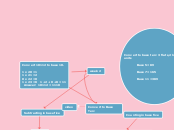av leslie nunez 8 år siden
253
week 2
Understanding different numerical bases is fundamental in mathematics. In base five, the digits are limited to 0, 1, 2, 3, and 4, contrasting with the base ten system which uses digits up to 9.

av leslie nunez 8 år siden
253

Mer som dette
Starting in the first column 6 - 3 = 3 but in the next column you need to borrow from the third column. Since this is base ten notation you are borrowing ten so the 6 in the third column becomes 5 and adding ten to 3 you have thirteen in the second column. subtraction
5 from 13 is 8 and 4 from 5 is 1 so the result is 183